Will Ethiopia's teff be the next 'super grain'?
- Published
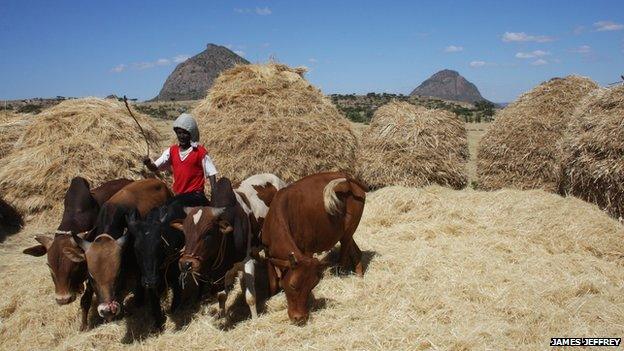
Under a bright blue sky, a farmer in a sleeveless red jumper is encouraging his five oxen to stamp on piles of dried grass, to help dislodge the seeds.
Nearby, other farm workers are using pitchforks to do the same job, throwing the grass into the air in an ancient process known as winnowing.
This is a harvest scene in rural Ethiopia, which at this time of the year is replicated across the length and breadth of the country.
The seed, or grain, in question is called teff.
Ethiopians have been growing and obsessing about teff for millennia, and it may become the new "super grain" of choice in Europe and North America, overtaking the likes of quinoa and spelt.
High in protein and calcium, and gluten-free, teff is already growing in popularity on the international stage.
Yet as teff is a staple foodstuff in Ethiopia, particularly when turned into a grey flatbread called injera, the country currently has a long-standing ban on exporting the grain, either in its raw form, or after it has been ground into flour.
Instead, entrepreneurial Ethiopian companies can at present only export injera and other cooked teff products, such as cakes and biscuits.
However, the hope is that if Ethiopia can sufficiently increase its teff harvest, then exports of the grain itself may be able to start in the not too distant future.
Air deliveries
"We started from scratch, and are now introducing our traditional food all over the world," says Hailu Tessema, founder of Mama Fresh, Ethiopia's first large-scale producer of injera.
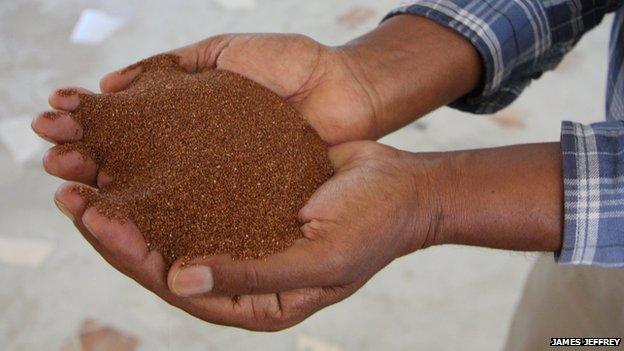
Grains of teff are as small as poppy seeds
Six days every week Mama Fresh uses Ethiopian Airlines to fly 3,000 injera flatbreads from Addis Ababa, the Ethiopian capital, to Washington DC in the US.
Injera is also flown to Sweden three times a week, Norway twice a week, and Germany three times a month.
"Demand is increasing by about 10% every month," says Mr Tessema, 60, who does not see the ban on exporting teff seeds as a problem.
"It's better to export a value-added product as that creates more jobs."
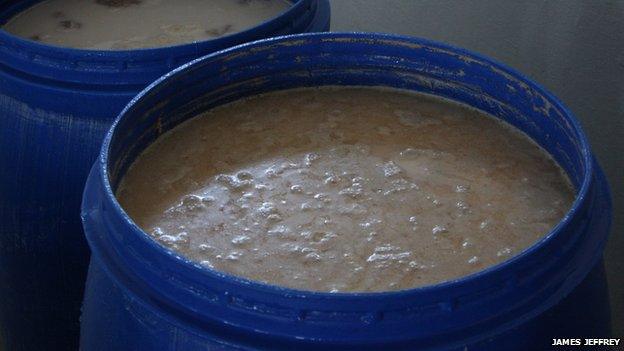
Teff flour is fermented before being turned into injera
Mama Fresh employs more than 100 people, and plans to take on another 50 this year. It also works with 300 farmers supplying teff.
Mr Tessema started the business in 2003 with 100,000 Ethiopian birr ($5,000; £3,225), operating out of a rickety shack.
The firm's annual revenue now stands at around 17m birr ($836,000; £566,000), and last year the business moved into a new factory.
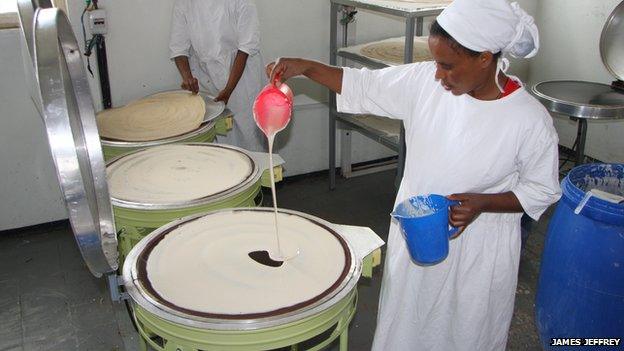
Injera is made by heating it like a pancake
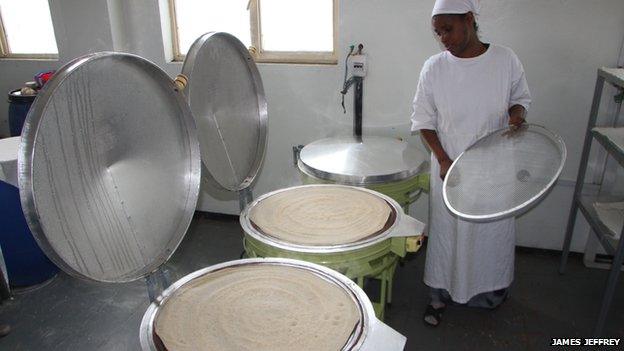
After a few minutes the injera is ready
Inside the facility, blue barrels contain teff flour mixed with water, which is left to ferment for four days.
Afterwards, women pour small jug-sized amounts onto heated-clay cookers to sizzle and become injera, ready for packaging and speedy onward flights to eager overseas customers, mainly diaspora Ethiopians.
A tiny grain the size of a poppy seed, teff is ground into a flour which can also be made into loaves of European-style risen bread or pasta.
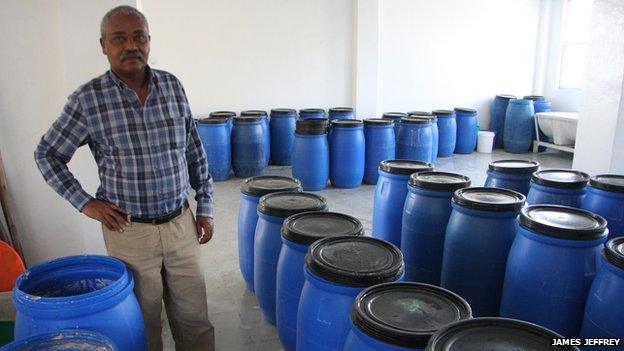
Hailu Tessema's company is exporting around the world
At London-based business, Tobia Teff, they use US-grown teff to make various breads and a porridge.
The company was founded by British-Ethiopian co-owner Sophie Sirak-Kebede, who originally opened an Ethiopian restaurant in the UK capital in 2003.
In 2008, she closed the restaurant to concentrate solely on selling teff.
"People are dreaming of teff nowadays, after thousands of years it has become the trendy thing over here," says the 58-year-old.
Tobia Teff's sales have increased by up to 40% during the last 14 months.
Even the UK's National Health Service has become a customer to cater for gluten-intolerant patients.
Achilles heel
Yet despite praise for teff's nutritional properties, its previously sheltered existence in Ethiopia comes with a drawback.
"Teff does not give much yield," says Zerihun Tadele, an Ethiopian researcher at the Institute of Plant Sciences at the University of Bern, Switzerland. "Very little research and investment has been done on the crop."
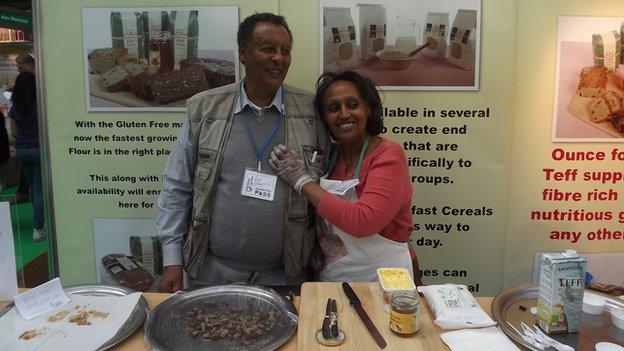
Sophie Sirak-Kebede is leading the promotion of teff in the UK
The average yield per hectare of teff in Ethiopia is 1.4 tonnes, which is less than half as much as the global average of 3.2 tonnes for modern varieties of wheat.
Mr Tadele hopes that through research and improved farming methods teff yields in Ethiopia can be raised to 5 tonnes a hectare.
This improvement will not come soon enough because recent teff harvests have failed to kept pace with Ethiopia's increasing population, driving prices beyond many Ethiopians' pockets, especially outside Addis Ababa.
Ms Sirak-Kebede says this situation creates a dilemma because "teff is Ethiopia's backbone". She adds: "A shortage of teff would be like asking an Ethiopian not to breathe".

Teff has been grown in Ethiopia for millennia
But at the same time, Ms Sirak-Kebede notes that the Ethiopian government should not squander a global opportunity that could benefit the more than six million farmers in the country that grow the seed, while also generating valuable foreign currencies.
The government's Agricultural Transformation Agency is now focused on increasing teff production to at least match domestic demand, after which exporting seeds and flour may become possible.

Teff facts
Teff is the seed of a grass native to Ethiopia known as lovegrass
It was one of the earliest cultivated plants
In Ethiopia teff is most often made into a pancake called injera, which is often used as a plate, with other foods placed on top
Gluten free

"The opportunity this presents to the country is significant and the benefit over the long term will far outweigh the risks," says Matthew Davis, a partner at US-based Renew Strategies, an early stage venture capital company investing in Mama Fresh.
"The government would likely proceed cautiously, only giving licences to select exporting companies."
No doubt the Ethiopian government has already looked nervously at the example of quinoa, which has become so popular on the global stage that many people in its native countries, such as Peru and Bolivia, can no longer afford to buy it.
If Ethiopia's teff export ban is ever lifted, Ms Sirak-Kebede says she wants to buy land in Ethiopia to farm the crop for her UK business.
"Being of Ethiopian origin I would prefer to get teff from Ethiopia," Ms Sirak-Kebede says.
"Who better than an Ethiopian farmer when it comes to teff? The quality is incomparable."